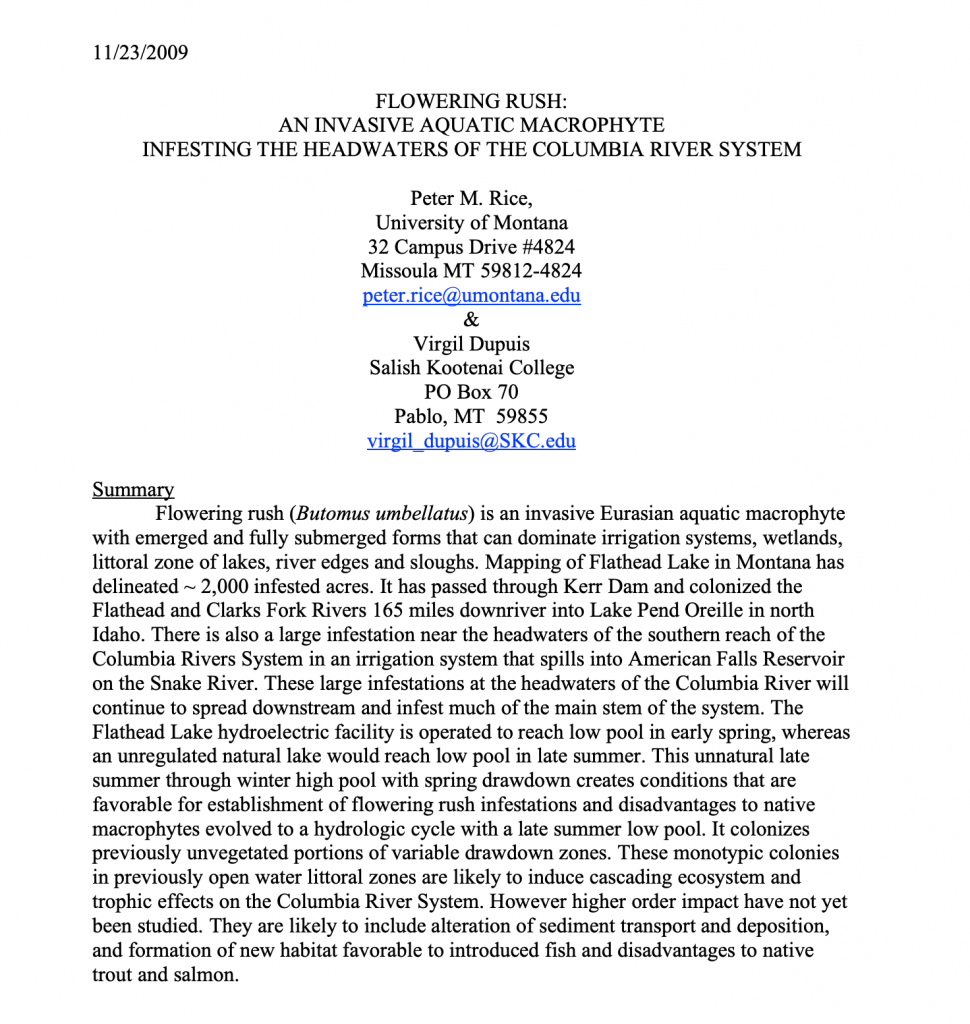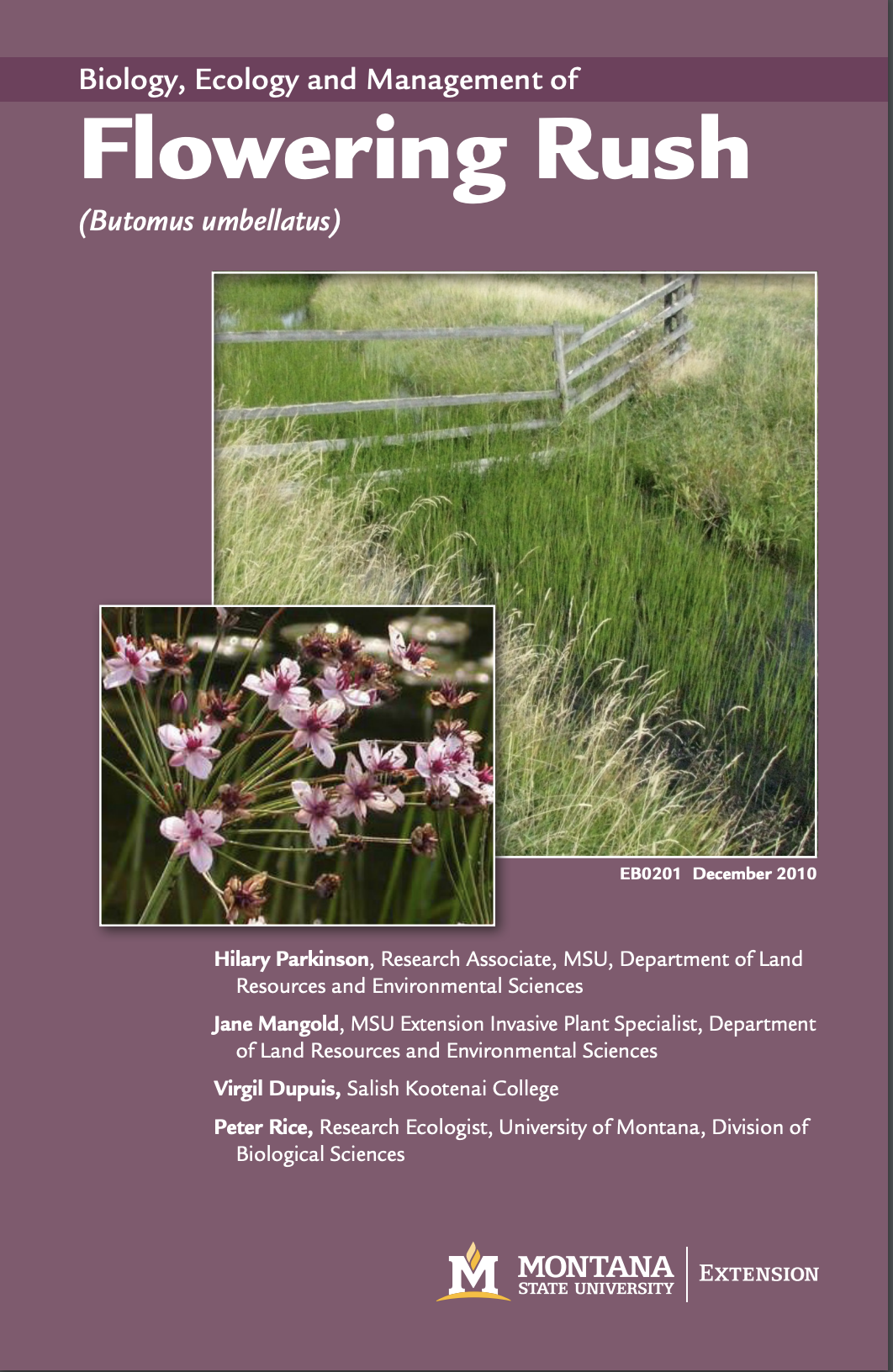SKCE Most Recent Co-Authored Publication!
Food Insecurity in the Rural United States: An Examination of Struggles and Coping Mechanisms to Feed a Family among Households with a Low-Income
Carmen Byker Shanks 1,2,*, Lauri Andress 3, Annie Hardison-Moody 4, Stephanie Jilcott Pitts 5,Megan Patton-Lopez 6, T. Elaine Prewitt 7, Virgil Dupuis 8, KarenWong 9, Marisa Kirk-Epstein 9,Emily Engelhard 10, Monica Hake 10, Isabel Osborne 3, Casey Hoff 2 and Lindsey Haynes-Maslow 11. (2022).

FLOWERING RUSH:
AN INVASIVE AQUATIC MACROPHYTE
INFESTING THE HEADWATERS OF THE COLUMBIA RIVER SYSTEM
Fish and Macroinvertebrate Trapping Data Report in Relation to Flowering Rush Infestations
Peter Rice & Virgil Dupuis, 5/30/2014

https://columbiabasincwma.org/wp-content/uploads/2019/05/Rice-P-V-Dupuis-2009.pdf

Biology, Ecology and Management of
Flowering Rush

http://msuextension.org/publications/AgandNaturalResources/EB0201.pdf

Mechanism of northern pike invasion in the Columbia River Basin River. Kellie J. Carim1,2,3,*, Lisa A. Eby3, Loren M. Miller4, Holly McLellan5, Virgil Dupuis6 and Michael K. Schwartz2 2021.

Abstract
The spread of aquatic invasive species typically occurs through a combination of natural and human mediated dispersal. For many aquatic invasive species, natural dispersal is limited to aquatic corridors connecting habitat. In contrast, human transport may facilitate more distant dispersal and transport among disconnected waterbodies. Genetic information can serve as a powerful tool to track invasion histories and identify both the sources and mechanisms of invasive species dispersal. We used genetic information to understand invasion history and dynamics of expanding northern pike invasion in the Columbia River basin. Results indicate that the initial introduction of northern pike into the Pend Oreille River (in eastern Washington State) resulted from human transport of fish, not dispersal from established populations upstream. Subsequent reproduction and natural dispersal from the Pend Oreille resulted in downstream expansion of northern pike into Lake Roosevelt, a reservoir within the mainstem Columbia River. These results highlight the need for a holistic approach to suppression of invasive species. Immediate efforts must address the biological mechanisms of natural dispersal. Sustained suppression and eradication must take a broad approach that includes coordination between management agencies, as well as policy and public outreach aimed at prevention of repeated human transport events. The genetic database created from this study has already been used to eliminate potential source populations for new northern pike invasions in Washington State outside the Columbia River basin. This highlights the utility of genetic monitoring for both immediate and long-term applications to managing aquatic species invasions.
https://www.reabic.net/journals/mbi/2022/1/MBI_2022_Carim_etal.pdf

Advancing Healthy and Sustainable Diets Publications
Advancing healthy and sustainable food environments: The Flathead Reservation case study. Ahmed S, Shanks CB, Dupuis V, Pierre M. https://www.ncbi.nlm.nih.gov/pmc/articles/PMC6953901/.UNSCN Nutr. 2019;44:38-45.

Dietary Quality Varies Among Adults on the Flathead Nation of the Confederated Salish and Kootenai Tribes in Montana. J Community Health. Byker Shanks C, Ahmed S, Dupuis V, et al. 2020;45(2):388-399. doi:10.1007/s10900-019-00753-3.https://pubmed.ncbi.nlm.nih.gov/31602533/

Contribution of wild foods to diet, food security, and cultural values amidst climate change. Journal of Agriculture, Smith, E., Ahmed, S., Dupuis, V., Running Crane, M., Eggers, M., Pierre, M., Flagg, K., & Byker Shanks, C. (2019). Food Systems, and Community Development, 9 (Suppl. 2), 191–214. https://doi.org/10.5304/jafscd.2019.09B.011

Intended and Unintended Consequences of a Community-Based Fresh Fruit and Vegetable Dietary Intervention on the Flathead Reservation of the Confederated Salish and Kootenai Tribes. 2020,Selena Ahmed1, Virgil Dupuis2, Michael Tyron2, MaryAnn Running Crane2, Teresa Garvin3, Michael Pierre4, Carmen Byker Shanks1, https://pubmed.ncbi.nlm.nih.gov/32850578/#affiliation-1

“Role of Wild Food Environments for Cultural Identity, Food Security, and Dietary Quality in a Rural American State.” Ahmed, Selena, Teresa Warne, Alyssa Stewart, Carmen Byker Shanks, and Virgil Dupuis. Frontiers in Sustainable Food Systems (2022): 153.

A pragmatic randomized trial of home-based testing for COVID-19 in rural Native American and Latino communities: Protocol for the “Protecting our Communities” study. Matthew J Thompson1, Paul K Drain2, Charlie E Gregor3, Laurie A Hassell3, Linda K Ko4, Victoria Lyon5, Selena Ahmed6, Sonia Bishop7, Virgil Dupuis8, Lorenzo Garza9, Allison A Lambert10, Carly Rowe3, Teresa Warne6, Eliza Webber6, Wendy Westbroek8, Alexandra K Adams11. 2022.


Terrestrial Invasive species publications
Working across Cultures to Protect Native American Natural and Cultural Resources from Invasive Species in California. Journal of Forestry. Alexander, Janice & Frankel, Susan & Hapner, Nina & Phillips, John & Dupuis, Virgil. (2016). 115. 10.5849/jof.16-018.


Sustainability Dimensions of Indigenous Peoples’ Food Systems in a Changing World
Selena Ahmed, Virgil Dupuis, John de la Parra, Alexandra Adams, and Long Chunlin

